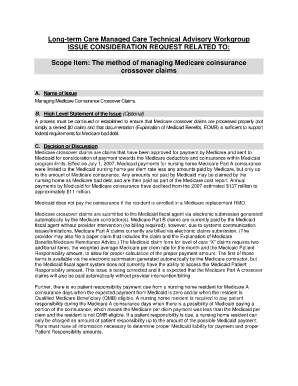

An explicit price concession occurs when a provider accepts a discount or concession to standard pricing that’s explicitly stated, e.g., a contractually negotiated rate or self-pay policy discount. Under FASB Topic 606, health care providers must differentiate between an explicit price concession, an implicit price concession and a bad debt under U.S.

GAAP for annual and interim periods beginning after December 15, 2017, and for annual periods beginning after December 15, 2018, for nonpublic entities. FASB Topic 606 was effective for public entities reporting under U.S.
MEDICARE CROSSOVER DEFINITION UPDATE
The implementation of FASB’s Accounting Standards Update 2014-09, Revenue from Contracts with Customers (Topic 606), introduced the concept of “implicit price concessions” into the health industry’s financial terminology. While this recent clarification of the CMS policy related to Medicare-Medicaid crossover bad debts will most likely be challenged and litigated by providers, CMS and providers must address a bigger issue related to bad debt expense-the adoption of FASB’s new standards on revenue recognition. This “clarification” is effective October 1, 2019. According to the April 4, 2019, CMS MLN Connects ® article, however, providers must classify the unmet Medicare deductible and coinsurance amounts for Medicare-Medicaid crossover bad debts to an expense account for uncollectible accounts and can’t write off the claim to a contractual allowance. generally accepted accounting principles (GAAP) among health care providers. With this historical guidance from CMS, there has long been a general consistency between the definition of bad debt for cost reports and the way bad debt expense is recognized under U.S.
MEDICARE CROSSOVER DEFINITION MANUAL
Historically, CMS has defined bad debt expense based on 42 CFR Section 413.89 and §302.1 of the Provider Reimbursement Manual (PRM), Part I, as “amounts to be uncollectible from accounts and notes receivable which are created or acquired in providing services” and “represent reductions in revenue.” Based on 42 CFR §413.20, CMS requires providers to “maintain sufficient financial records … which are widely accepted in the hospital and related fields.” Further, for cost report purposes, an unmet deductible or coinsurance amount related to Medicare beneficiaries who also are Medicaid eligible could be claimed by providers as a reimbursable Medicare bad debt if the bad debt was deemed uncollectible and there’s no likelihood of recovery in accordance with 42 CFR §413.89.

To understand the challenges this creates, we must first consider how things used to be. On April 4, 2019, CMS caused a stir in the provider community by releasing a Medicare Learning Network (MLN) Connects ® article to clarify its position related to the accounting treatment for Medicare-Medicaid crossover bad debts. And things may have just gotten more challenging! Understanding and calibrating the differences in reporting bad debts and other uncompensated costs among the cost report, IRS Form 990, financial statements and other filings, such as a community benefits report, has always been a significant endeavor for providers.


 0 kommentar(er)
0 kommentar(er)
